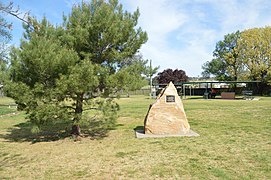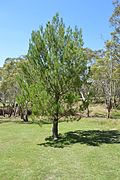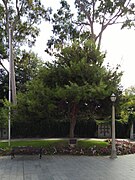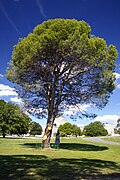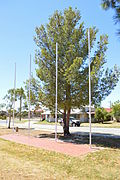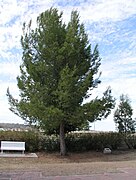
A pine is any conifer tree or shrub in the genus Pinus of the family Pinaceae. Pinus is the sole genus in the subfamily Pinoideae. World Flora Online, created by the Royal Botanic Gardens, Kew and Missouri Botanical Garden, accepts 187 species names of pines as current, together with more synonyms. The American Conifer Society (ACS) and the Royal Horticultural Society accept 121 species. Pines are commonly found in the Northern Hemisphere. Pine may also refer to the lumber derived from pine trees; it is one of the more extensively used types of lumber. The pine family is the largest conifer family and there are currently 818 named cultivars recognized by the ACS. It is also a well-known type of Christmas tree.

Pinus canariensis, the Canary Island pine, is a species of gymnosperm in the conifer family Pinaceae. It is a large, evergreen tree, native and endemic to the outer Canary Islands of the Atlantic Ocean.

The stone pine, botanical name Pinus pinea, also known as the Italian stone pine, Mediterranean stone pine, umbrella pine and parasol pine, is a tree from the pine family (Pinaceae). The tree is native to the Mediterranean region, occurring in Southern Europe and the Levant. The species was introduced into North Africa millennia ago, and is also naturalized in the Canary Islands, South Africa and New South Wales.
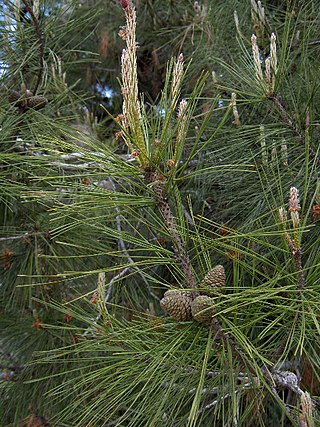
Pinus brutia, commonly known as the Turkish pine and Calabrian pine, is a species of pine native to the eastern Mediterranean region. The bulk of its range is in Turkey, but certain varieties are naturalized as far east as Afghanistan. It is also known as East Mediterranean pine, Afghan pine, and Brutia pine. The name "Calabrian pine" comes from an introduced grove in the Calabria region of southern Italy; historically this region was called Bruttium, which is likely where the specific epithet "brutia" comes from. Pinus brutia bears many similarities with other, closely related species such as Pinus halepensis and Pinus canariensis. Turkish pine forms a species complex with the former.
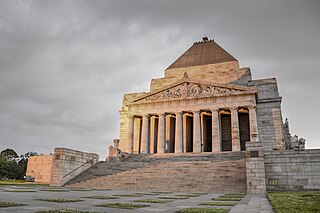
The Shrine of Remembrance is a war memorial in Melbourne, Victoria, Australia, located in Kings Domain on St Kilda Road. It was built to honour the men and women of Victoria who served in World War I, but now functions as a memorial to all Australians who have served in any war. It is a site of annual observances for Anzac Day and Remembrance Day, and is one of the largest war memorials in Australia.

Pinus halepensis, commonly known as the Aleppo pine, also known as the Jerusalem pine, is a pine native to the Mediterranean region.

Pinus pinaster, the maritime pine or cluster pine, is a pine native to the south Atlantic Europe region and parts of the western Mediterranean. It is a hard, fast growing pine bearing small seeds with large wings.

Marchalina hellenica is a scale insect that lives in the eastern Mediterranean region, mainly in Greece and Turkey. It is an invasive species in Melbourne, Australia. It lives by sucking the sap of pine trees, mainly the Turkish Pine and, to smaller extent, Aleppo Pine, Scots Pine and Stone Pine. It can be found in the cracks and under the scales of the bark of these trees, hidden under the white cotton-like wax it secretes. Its main form of reproduction is parthenogenesis.
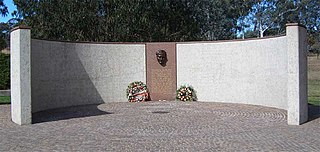
The Kemal Atatürk Memorial is a memorial directly opposite the Australian War Memorial on Anzac Parade, the principal memorial and ceremonial parade in Canberra, the capital of Australia.
Pine honey is a type of honeydew honey. It is a sweet and spicy honey, with some woody notes, a resinous fragrance and dark amber color. It is a common breakfast dish in Turkey and Greece, where it is drizzled over yoghurt and eaten with bread.

The Crimean Submediterranean forest complex is an ecoregion on the Black Sea coast of Russia and Ukraine. It is in the temperate broadleaf and mixed forests biome.

Lone Pine Cemetery is a Commonwealth War Graves Commission cemetery dating from World War I in the former Anzac sector of the Gallipoli Peninsula, Turkey and the location of the Lone Pine Memorial, one of five memorials on the peninsula which commemorate servicemen of the former British Empire killed in the campaign but who have no known grave.
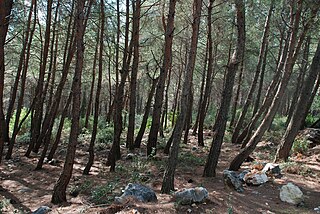
Forest resources in Syria are in need of study and conservation. The wooded area of the country is variously reported as approximately 190,000 hectares or 450,000 hectares.
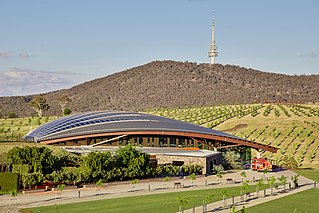
The National Arboretum Canberra is a 250-hectare (620-acre) arboretum in Canberra, the national capital of Australia, created after the area was burned out as a result of the Christmas 2001 and 2003 Canberra bushfires: The Himalayan Cedar forest lost about one third of its trees, and the commercial Radiata Pine plantation was burned out, allowing the arboretum to be created.

The Aegean and Western Turkey sclerophyllous and mixed forests is an ecoregion in the lands around the Aegean Sea. The ecoregion covers most of mainland Greece, the Greek Aegean Islands, the western coast of Turkey, the southern Vardar river valley in North Macedonia, the southern Struma river valley at the extreme south-western corner of Bulgaria.
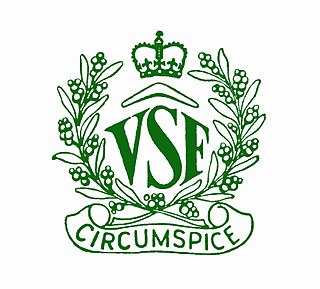
The Victorian School of Forestry (VSF) was established in October 1910 at Creswick, in the Australian state of Victoria. It was located at the former Creswick Hospital, built in 1863 during the gold rush. The creation of VSF was one of the many recommendations of a Royal Commission held between 1897 and 1901 into forest degradation. The first tertiary forestry school in Australia, VSF was administered by the Forests Commission Victoria (FCV) until 1980, when VSF amalgamated with the University of Melbourne to become that institution's School of Ecosystem and Forest Sciences. From 1910 to 1980, 522 students completed the Diploma of Forestry at VSF.
Seih Sou or Seikh Su, also known as Kedrinos Lofos, is a hilltop forest just to the north and northeast of the city of Thessaloniki, Greece, that rises to the west of Mount Chortiatis. The forest covers 2,979 hectares and reaches an elevation of 563 meters.
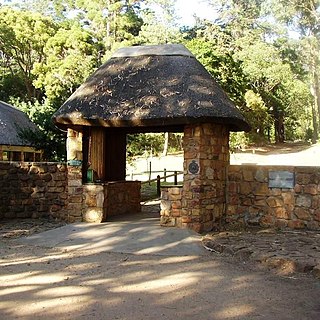
The Tokai Arboretum was the first large-scale silviculture experimental station in Cape Town, South Africa. The area of the main Arboretum, at Tokai Park, is 14 ha. Several adjacent compartments extend the area to 26 ha. The Arboretum was declared a National Monument in 1985, on its 100th anniversary. It contains stands of Eucalyptus and other trees from the original silviculture experiments in South Africa. In the 1990s a Gondwana Garden was created to display the plants typical of the Cape 100 million years ago.






